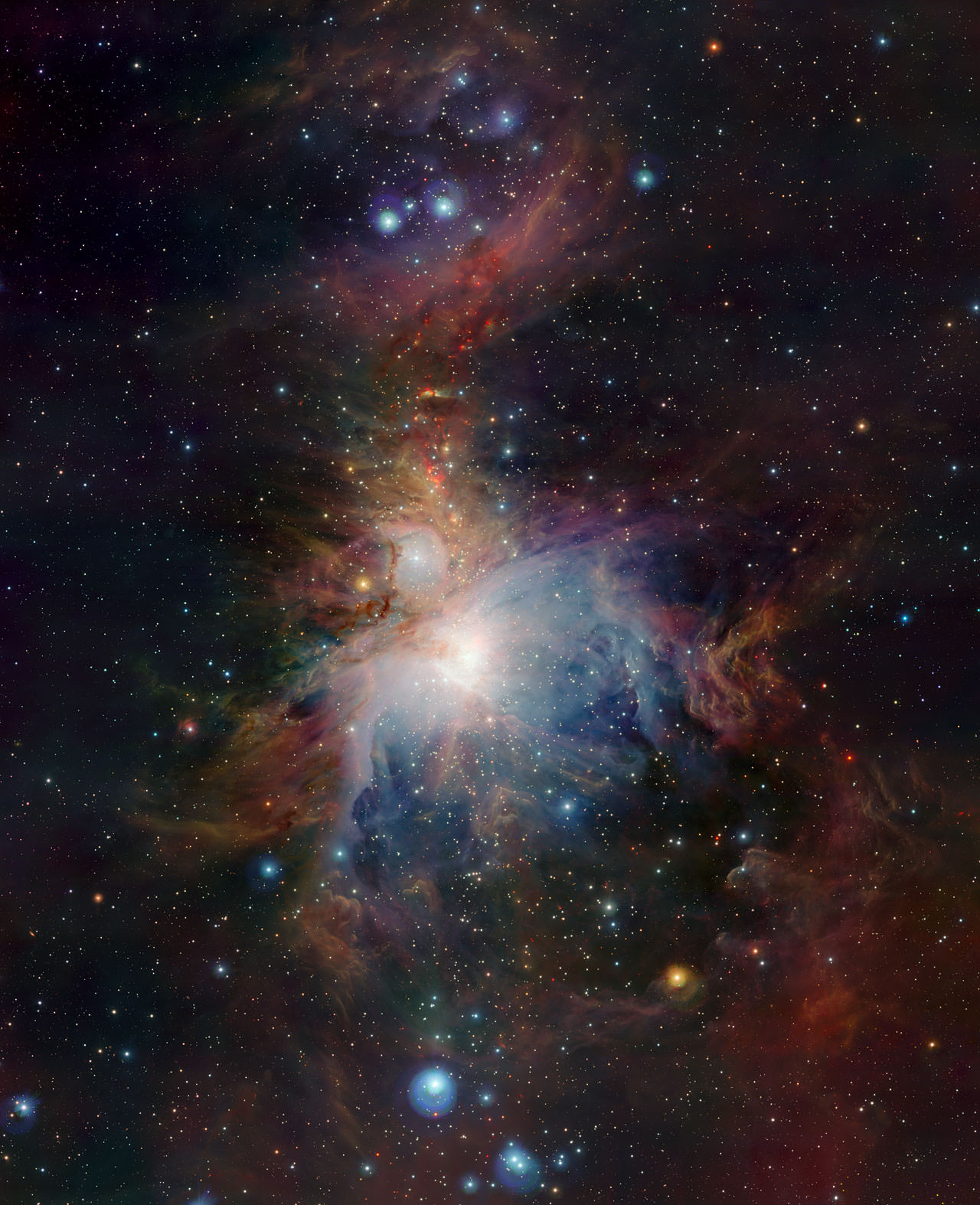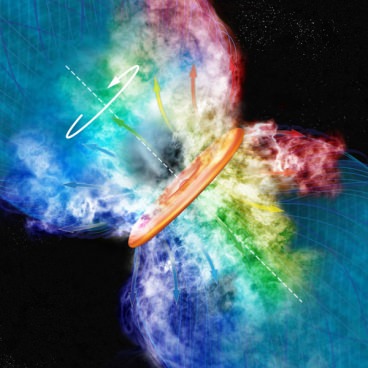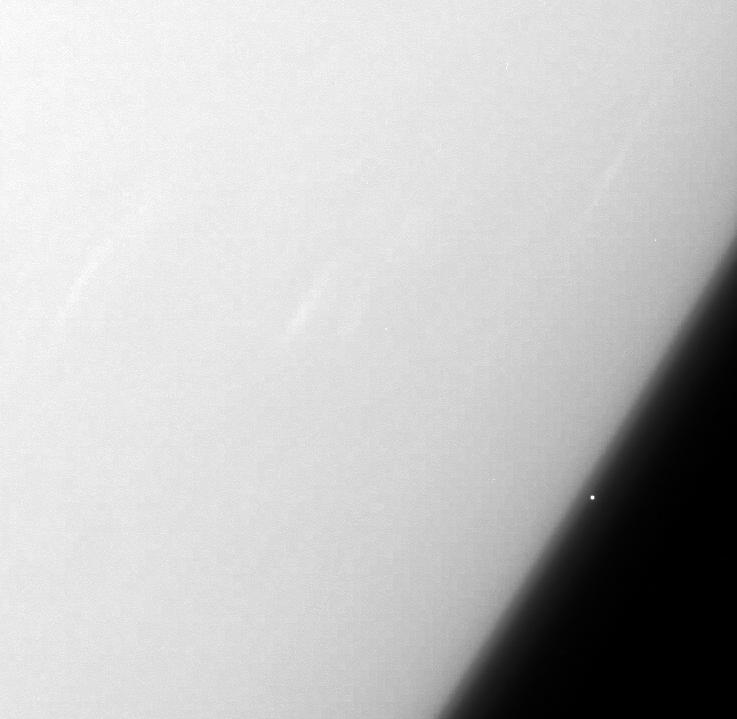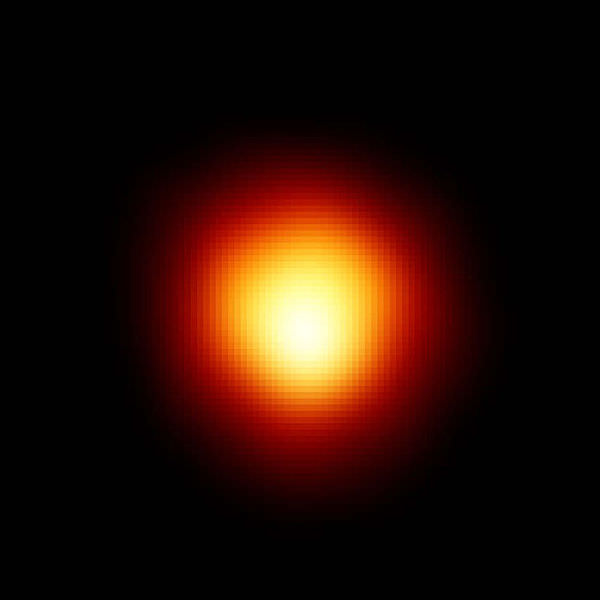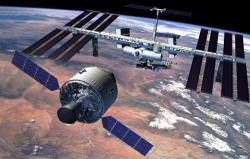NASA successfully tested the pad abort system developed for the Orion crew vehicle on Thursday morning at the White Sands Missile Range near Las Cruces, New Mexico. The 97-second flight test was the first fully integrated test of the Launch Abort System developed for Orion. “It was a big day for our exploration team,” said Doug Cooke, NASA’s Associate Administrator for Exploration following the test. “It looked flawless from my point of view. This is the first abort system the US has developed since Apollo, but it uses much more advanced technologies. It was a tremendous effort to get to this point, designing such a complex system, and we’ve been working on this for about 4 years. I appreciate the amount of dedication and focus from the team. It was beautiful, a tremendous team effort.”
Continue reading “Successful Test for Orion Launch Abort System”
Obama Compromises, Brings Back Orion Capsule; Allows for Heavy Lift Sooner
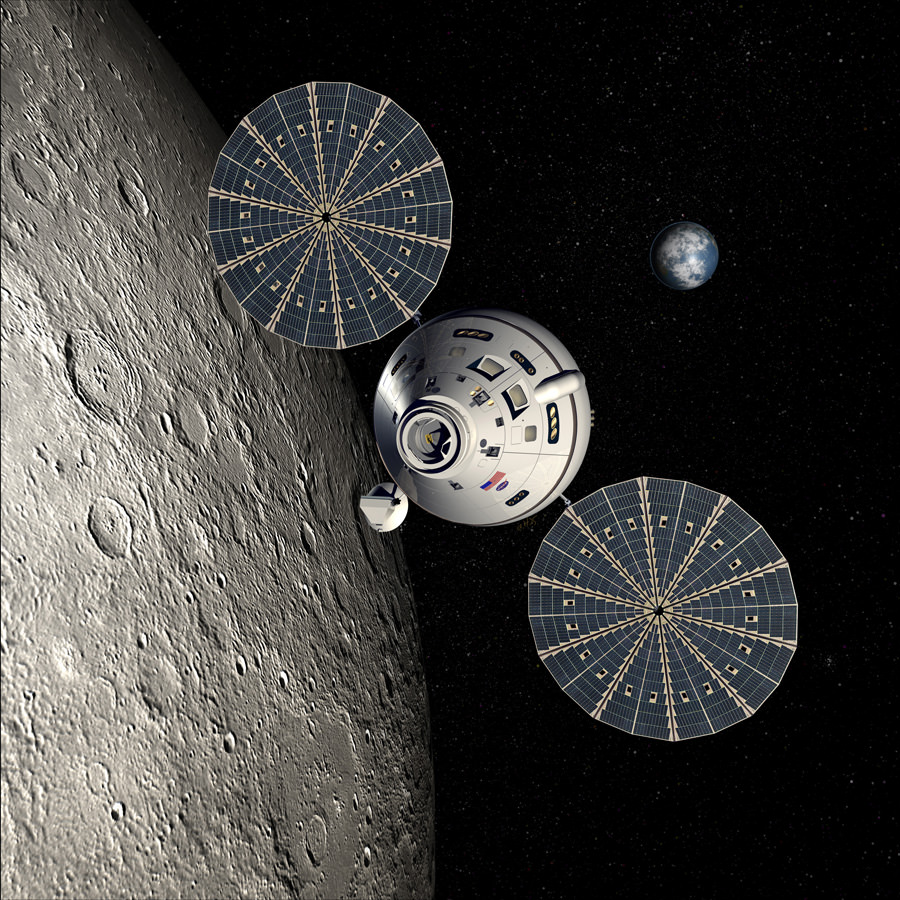
[/caption]
In what could be considered a compromise in his proposed budget for NASA, President Obama is reviving the Orion crew capsule concept that he had canceled with the rest of the Constellation program earlier this year, according to an article by Seth Borenstein of the Associated Press. This should mean more jobs and less reliance on the Russians, officials said Tuesday. While Orion, still won’t go to the moon. It will go unmanned to the International Space Station to stand by as an emergency vehicle to return astronauts home, officials were quoted in the article.
Borenstein also reported that NASA will speed up development of a heavy lift rocket. It would have the power to blast crew and cargo far from Earth, although no destination has been chosen yet. The rocket supposedly would be ready to launch several years earlier than under the old moon plan.
The two moves are being announced before the “Space Summit” on Thursday, a visit to Kennedy Space Center by Obama. They are designed to counter criticism of the Obama administration’s space plans as being low on detail, physical hardware, and local jobs.
The President’s plan had been met with much criticism, including an open letter to Obama drafted by several former astronauts, flight directors and other former NASA officials.
A briefing at the White House Now said that the president is committed to choosing a single heavy-lift rocket design by 2015 and then starting its construction.
Reportedly, the new Obama program will mean 2,500 more Florida jobs than the old Bush program, a senior White House official told Borenstein. In addition, as we reported earlier, the commercial space industry on Tuesday released a study that said the president’s plan for private ships to fly astronauts to and from the space station would result in 11,800 jobs.
“We wanted to take the best of what was available from Constellation,” the NASA official told The Associated Press as part of a White House briefing.
New VISTA of Orion
[/caption]
Oh-oh-oh Orion! The new VISTA (Visible and Infrared Survey Telescope for Astronomy) infrared survey telescope has used its huge field of view to show the full splendor of the Orion Nebula. With its infrared eyes, it has peered deeply into dusty regions that are normally hidden to expose the curious behavior of the very active young stars buried there.
VISTA is the latest addition to ESO’s Paranal Observatory. It is the largest survey telescope in the world and is dedicated to mapping the sky at infrared wavelengths. The large (4.1-metre) mirror, wide field of view and very sensitive detectors make VISTA a unique instrument. This dramatic new image of the Orion Nebula illustrates VISTA’s remarkable powers.
The Orion Nebula is about 1,350 light-years from Earth. Although spectacular when seen through an ordinary telescope, what can be seen using visible light is only a small part of a cloud of gas in which stars are forming. Most of the action is deeply embedded in dust clouds and to see what is really happening astronomers need to use telescopes with detectors sensitive to the longer wavelength radiation that can penetrate the dust. VISTA has imaged the Orion Nebula at wavelengths about twice as long as can be detected by the human eye.
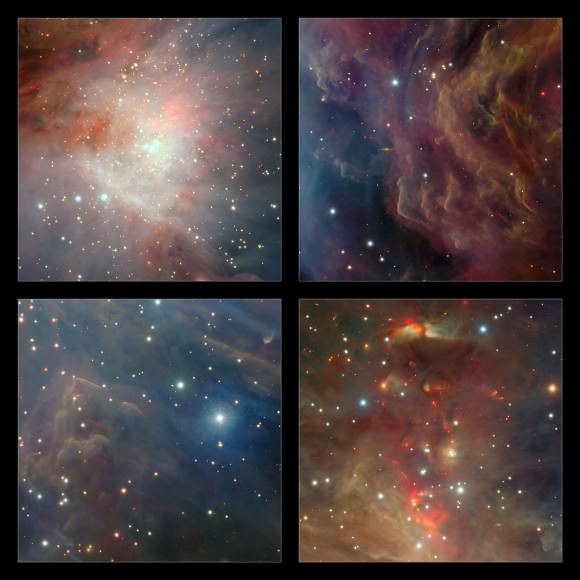
On the upper-left, the central region of VISTA’s view of the Orion Nebula is shown, centered on the four dazzling stars of the Trapezium. A rich cluster of young stars can be seen here that is invisible in normal, visible light images. In the lower-right panel the part of the nebula to the north of the center is shown. Here there are many young stars embedded in the dust clouds that are only apparent because their infrared glow can penetrate the dust and be detected by the VISTA camera. Many outflows, jets and other interactions from young stars are apparent, seen in the infrared glow from molecular hydrogen and showing up as red blobs. On the upper-right, a region to the west of center is shown. Here the fierce ultraviolet light from the Trapezium is sculpting the gas clouds into curious wavy shapes. A distant edge-on spiral galaxy is also seen shining right through the nebula. At the lower-left a region south of the center is shown. Each extract covers a region of sky about nine arcminutes across.
All these features are of great interest to astronomers studying the birth and youth of stars.
Source: ESO
Time-Lapse Movie Shows Massive Stars Form Similarly to Smaller Stars
It has been difficult for astronomers to see how massive stars form, since these stars are rare, form quickly and tend to be enshrouded in dense, dusty material which obscures them from view. But astronomers using the Very Long Baseline Array (VLBA) radio telescope were able to take images of the wavelengths of light emitted by a massive young star located 1,350 light years away in the Orion constellation. The created a ‘movie’ from the data, which they say shows the first evidence that young massive stars form from an accretion disk, just as smaller stars form.
“It is the first really ironclad confirmation that massive young stars are surrounded by orbiting accretion disks, and the first strong suggestion that these disks launch magnetically driven winds,” said Mark Krumholz, from the University of California at Santa Cruz.
The astronomers, led by Lynn D. Matthews from the Haystack Observatory at MIT, were able to see a disk of gas swirling close to the young massive star, known as Source I (said like “Source Eye”) in the high-resolution time-lapse movie they created.
By assembling 19 individual images of Source I taken by the VLBA at monthly intervals between March 2001 and December 2002, the high-resolution movie reveals thousands of masers, radio emitting gas clouds that can be thought of as naturally occurring lasers, located close to the massive star. According to Matthews, only three massive stars in the entire galaxy are known to have silicon monoxide masers. Because the silicon monoxide masers emit beams of intense radiation that can pierce the dusty material surrounding Source I, the scientists could probe the material close to the star and measure the motions of individual gas clumps.
Click here to see the time-lapse movie.
For almost 20 years, astronomers have known that low-mass stars form as a result of disk-mediated accretion, or from material formed from a structure rotating around a central body and driven by magnetic winds. But it had been impossible to confirm whether this was true for massive stars, which are eight to 100 times larger than low-mass stars. Without any hard data, theorists proposed many models for how massive stars might form, such as via collisions of smaller stars.
“This work should rule out many of them,” Krumholz said.
Because massive stars are believed to be responsible for creating most of the chemical elements in the universe that are critical for the formation of Earth-like planets and life, understanding how they form may help unravel mysteries about the origins of life.
The VLBA consists of a network of 10 radio telescope dishes located across North America, and can be thought of as a virtual telescope 5,000 miles in diameter. Used as a zoom lens to penetrate the dusty cloud surrounding the massive star, the VLBA captured images up to 1,000 times sharper than those previously obtained by other telescopes, including NASA’s Hubble Space Telescope.
The team’s paper was published in the Jan. 1 issue of the Astrophysical Journal.
Lead image caption: Artist’s conception of the rotating disk of hot, ionized gas surrounding Orion Source I, blocking the star from our view. A cool wind of gas is driven from the upper and lower surfaces of the disk and is sculpted into an hourglass shape by tangled magnetic field lines. Image: Bill Saxton, National Radio Astronomy Observatory/Associated Universities, Incorporated/National Science Foundation
Source: MIT
Rigel
Rigel is the brightest star in the constellation of Orion; despite that, its formal name (one of them anyway) is Beta Orionis (Alpha Orionis – Betelgeuse – is a variable star, as is Rigel; Betelgeuse is sometimes the brighter, but most of the time is the fainter).
Rigel is a blue supergiant (spectral class B8I), the brightest of its kind in the sky. It’s also a multiple star system … the primary is the blue supergiant which totally dominates the observed light, and the secondary (Rigel B) is itself a close (spectroscopic) binary (B, and C, are both of B spectral class too … but are main sequence stars). HIPPARCOS data puts Rigel at a distance of ~850 light-years, but with a large uncertainty (GAIA will nail down its distance much more accurately).
Being a blue star, Rigel emits most of its light in the UV; if it is 850 light-years distant, its luminosity is approximately 85,000 sols, its radius ~75 sols (or ~0.35 au; if it were where the Sun is, Mercury would be almost inside it), its mass about 18 sols, and it is only approximately 10 million years old. It is likely to have a non-burning helium core (i.e. it is in its hydrogen shell-burning phase), and on its way to becoming a red supergiant (like Betelgeuse), and after that a supernova.
A couple of degrees away, on the sky, is the Witch-Head Nebula (IC 2118), which is a reflection nebula. And which star’s light is it reflecting? You guessed it, Rigel’s! Now as IC 2118 is about 40 light-years from Rigel, it demonstrates well just how much light Rigel is emitting.
Rigel may be part of the Orion OB1 association, if it were kicked out at around its birth (it’s too far, today, from the other stars in the association to be a member unless it is moving away at rather a fast clip).
Some of the Universe Today articles which feature Rigel include Rigel Passes Behind Saturn, Astrophoto: The Witch Head Nebula by Richard Payne, and IYA 2009 – Brian Sheen Reports on “Canoe Africa”.
Two Astronomy Cast episodes which relate to Rigel are The Life of Other Stars (in particular, the life of stars much more massive than the Sun), and Stellar Populations (in particular, the range of types of stars born from the same natal nebula).
Horsehead Nebula
[/caption]
The Horsehead nebula is a dark nebula that looks like a horse’s head! It is part of the Orion Molecular Cloud complex, and has the more correct, if boring, name Barnard 33 (being object number 33 in a catalog of dark nebulae, by Barnard).
It is about 1500 light-years away, and is itself dark because of the dust of which it’s made (it’s also made up of gas, in fact it’s mostly gas, but the gas is essentially transparent). What makes it so obvious is the diffuse glow from behind it; the glow is red – due to the Balmer Hα line, a prominent atomic transition in hydrogen – and is powered by the UV light from the nearby star, Sigma Orionis (which is actually a five-star system), which ionizes the hydrogen gas in this part of the Orion Complex.
The first record of its shape is from 1888, by Williamina Fleming, who noticed it on a photographic plate taken at the Harvard College Observatory (Fleming made significant contributions to astronomy, including cataloguing many of the stars in the famous Henry Draper Catalogue). The Horsehead nebula is a favorite of amateur astronomers, especially astrophotographers (it’s quite difficult to spot visually).
The Horsehead nebula is similar to the Pillars of Creation (in M16), though perhaps not as dense; one day it too will be eroded by the intense UV from the young stars in its vicinity, and from new-born stars formed within it (the bright area at the top left is light from just such a star).
In 2001, the Hubble Space Telescope Institute asked the public to vote for an astronomical target for the Hubble Space Telescope to observe, a sort of Universe Idol contest … the Horsehead nebula was the clear winner! Hands up all of you who have, or have had, the Hubble’s image of the Horsehead as your wallpaper, or perhaps the VLT one …
Universe Today has, among its stories, some good background on the Horsehead; for example Dark Knight Ahead – B33 by Gordon Haynes, Astrophoto: The Horsehead Nebula by Filippo Ciferri, and What’s Up This Week – Jan 3 – Jan 9, 2005.
The Astronomy Cast episode Nebulae explains the role of dark nebulae, such as the Horsehead, in starbirth; well worth a listen.
Betelgeuse
[/caption]
Betelgeuse is the ninth brightest star in the sky, and the second brightest in the constellation of Orion (it’s the red one, on the opposite side of the Belt from Rigel, which is the blue one, and the brightest).
With a mass of some 20 sols (= the mass of 20 Suns), Betelgeuse is evolving rapidly, even though it’s only a few million years old. It’s now a red supergiant, burning helium in a shell, and (very likely) burning carbon in another shell (closer to the nucleus), and (possibly) oxygen, silicon, and sulfur in other nested shells (like Russian dolls).
Betelgeuse is enormous … if it were where the Sun is, all four inner planets would be inside it! Because it’s so big, and is only approx 640 light-years away, Betelgeuse appears to about 1/20 of an arcsecond in size; this made it an ideal target for optical interferometry. And so it was that in 1920 Michelson and Pease used the 100″ Mt Wilson telescope, with a 20 m interferometer attached to the front, to measure Betelgeuse’s diameter.
The Hubble Space Telescope imaged Betelgeuse directly, in 1995, in the ultraviolet (see above). Why the UV? Because ground-based telescopes can’t make such observations, and because the Hubble’s resolution is greatest in the UV.
Since the 1920s Betelgeuse has been observed, from the ground, by many different optical interferometers, at many wavelengths. Its diameter varies somewhat, as does its brightness (Herschel is perhaps the first astronomer to describe its variability, in 1836). It also has ‘hotspots’, which are ginormous.
Betelgeuse is also shedding mass in giant plumes that stretch to over six times its diameter. Although these plumes will certainly cause it to ‘slim down’, they won’t be enough to stop its core turning to iron (when the silicon there is exhausted, if it hasn’t already done so). Not long afterwards, perhaps within the next thousand years or so, Betelgeuse will go supernova … making it the brightest and most spectacular supernova visible from Earth in perhaps a million years. Fortunately, because we are not looking directly down on its pole, when Betelgeuse does go bang, we won’t be fried by a gamma ray burst (GRB) which may occur (while a core collapse supernova can cause one kind of GRB, it is not yet known if all such supernovae produce GRBs; in any case, such a GRB is one of a pair of jets which rip through the poles of the dying star).
AAVSO has an excellent article on Betelgeuse, and COAST’s (Cambridge Optical Aperture Synthesis Telescope) webpage on its observations of Betelgeuse gives a good summary of one interferometric technique (and some great images too!).
Universe Today has many stories on just about every aspect of Betelgeuse, from its varying size (The Curious Case of the Shrinking Star), the bubbles it’s blowing and its plumes (Closest Ever Look at Betelgeuse Reveals its Fiery Secret), featured in What’s Up This Week, to the bow shock it creates in the interstellar medium (The Bow Shock of Betelgeuse Revealed).
Astronomy Cast’s The Life of Other Stars is a whole episode on the evolution of stars other than the Sun.
References:
http://en.wikipedia.org/wiki/Betelgeuse
http://www.solstation.com/x-objects/betelgeuse.htm
Water or Land: The Orion Landing Choice
Work is progressing on designing the new Orion Crew Exploration Vehicle (CEV), the next generation of NASA spacecraft that will take humans to the International Space Station, back to the Moon, and hopefully on to Mars. But one major question about the spacecraft has yet to be answered. On returning to Earth, will the CEV splash down in water, or land on terra firma?
NASA officials discussed various aspects of development that is currently underway for the Constellation program at a media briefing on December 10. The mobile launch platform for the Ares rocket is being built, landing parachutes have been tested and the first capsule structure of the new CEV will be constructed starting in early 2008. Design requirements for the booster rockets have been completed and just ahead are final design definitions for operational capabilities such as ground procedures at Kennedy Space Center, mission control in Houston and other areas such as spacesuit design.
Additionally research on the International Space Station has begun to help prepare for long duration spaceflights such as a measurements of microbe growth, a study of the formation of kidney stones, and a nutritional study to help understand what is “normal” for the human body in space.
But questions from the media focused mainly on the yet unmade decision of whether the CEV will land in the water or on land.
NASA originally explored multiple options for landing in both water and land. After initial studies, the first assessment by NASA and the contractor for the CEV, Lockheed Martin, was that landing on land was preferred in terms of total life cycle costs for the vehicles. But now a splashdown in water seems to be favored.
“There are a couple of aspects that pop out at us,” said Jeff Hanley, Manager for the Constellation Program. “One is the safety and the risks involved in landing. Looking at the landing itself, the event of actually touching down, water comes out to be preferable as less risk. Another aspect is the performance of the Orion vehicle as it is sent to the moon. In looking at what it takes to get a pound of spacecraft to low lunar orbit in terms of the cost, every pound that you send toward the moon is precious. From an efficiency and performance point of view, carrying 1500 lbs of landing bags to the moon and back when we have a perfectly viable mode of landing in the water near a US coastal site didn’t seem like a good trade in performance. We’ve tended toward updating our point of departure concept to now be a nominal US coastal water landing.”
The Constellation program has always considered that for the first few missions, the spacecraft would land in water until the guidance system had been tested thoroughly and proven in actual landings.
But NASA is continuing to look at landing on land as a possibility for future flights. “We want to be able to land on land in a contingency and have the crew be able to get out and walk away. Ther are limitation of what you can do on land but by the time we get done really looking at what the minimal capability of landing on land and having the crew walk away, we’ll see what the design looks like, and if the design is robust enough we could return to having nominal land landings.”
One challenge for the Constellation program has been getting the CEV light enough for the Ares rockets to be able to launch it, and therefore eliminating the 1500 lb airbags for landing has its appeal.
“The predominant design philosophy for Orion and Ares 1 has been that we are designing for lunar missions,” continued Hanley. “We will service the International Space Station within that set of capabilities. From that perspective, designing a lot of mass into the spacecraft just to enable land landings has not traded out to be an effective use of our performance. That’s the major consideration in play. Right behind that are life cycle costs.”
Making the decision of land vs. water is the goal for 2008 for the Constellation program. “We’ve studied and have cost estimates for water landings against the infrastructure costs of having multiple landing sites on land and they are comparable,” said Hanley. Right now, NASA is looking at a single target landing zone off the coast of California with one or two recovery vessels.
But they are keeping their options open for a land landing. “If the Orion team is able to come in at the preliminary design review later this next year with a concept for be able to land on land that is fairly robust but not cost a lot of mass to have to hurl to the moon and back, then it becomes an operational decision,” said Hanley.
There has been much debate about what type of landing would be best. “There’s been a lot of assumptions made that landing on land is going to be better, but there are lot of people in the technical community that do not buy into that,” said Hanley. “There’s been a lot of debate surrounding whether or not land landing truly is better from a life cycle cost perspective and there isn’t a lot of quantitative data to really pull from.”
Hanley feels there are assumptions being made but not a lot of substantive date to clarify what the right answer is. So the next steps are to get the spacecraft to a detailed preliminary design and really interrogate the water vs. land issue. That includes further developing the operational concepts , such as how long does the capsule stay in the water, and what loads does the spacecraft see from landing on water and land. Those are all questions that need to be answered in order to make a final decision on the type of landing that will be used.
Stay tuned, as 2008 should be a year of decision for many details about Constellation and the CEV.
Original News Source: NASA News Audio

